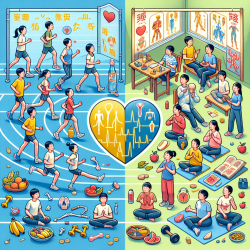In recent years, the rising prevalence of overweightness and obesity among adolescents has become a pressing public health concern in China. A study titled Weight Status, Physical Fitness, and Health-Related Quality of Life among Chinese Adolescents: A Cross-Sectional Study explores the intricate relationship between physical fitness, body mass index (BMI), and health-related quality of life (HRQOL) in this demographic. This research offers valuable insights for practitioners aiming to enhance adolescent well-being through targeted interventions.
The Study's Key Findings
The study involved 10,007 students from 30 secondary schools in Shandong, China. It assessed BMI, cardiorespiratory fitness (CRF), musculoskeletal fitness (MSF), and HRQOL using a comprehensive questionnaire. The findings revealed that both BMI and physical fitness levels are associated with various dimensions of HRQOL.
- BMI: Higher BMI was linked to lower social activity opportunities for both boys and girls.
- CRF: For boys, CRF was associated with better teacher-student relationships and self-satisfaction. For girls, it influenced parent-child relationships and self-perception.
- MSF: MSF was related to physical sense in boys and self-perception in girls.
Implications for Practitioners
The study underscores the importance of promoting physical activity and improving fitness levels to enhance adolescents' HRQOL. Practitioners can implement several strategies based on these findings:
- Design Tailored Exercise Programs: Schools should develop exercise programs that cater to the diverse needs of students, focusing on improving CRF and MSF.
- Encourage Active Participation: Teachers and parents should encourage students to engage in physical activities that align with their interests to foster a positive attitude towards fitness.
- Create Supportive Environments: Schools should create environments that support physical activity by providing adequate facilities and opportunities for students to be active.
The Need for Further Research
This study provides a foundation for understanding the relationship between physical fitness and HRQOL among Chinese adolescents. However, further research is needed to explore these associations over time and across different cultural contexts. Longitudinal studies could offer deeper insights into how changes in fitness levels impact HRQOL over the adolescent years.
The findings also highlight the need for more comprehensive measures that consider chronic illnesses or comorbidities affecting HRQOL. By expanding research efforts, practitioners can develop more effective interventions tailored to the unique needs of adolescents.
To read the original research paper, please follow this link: Weight Status, Physical Fitness, and Health-Related Quality of Life among Chinese Adolescents: A Cross-Sectional Study.










